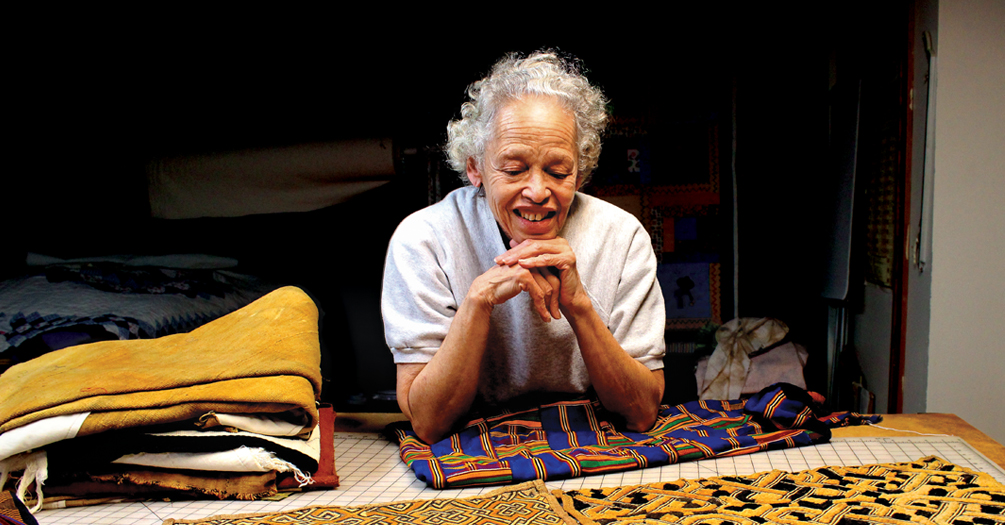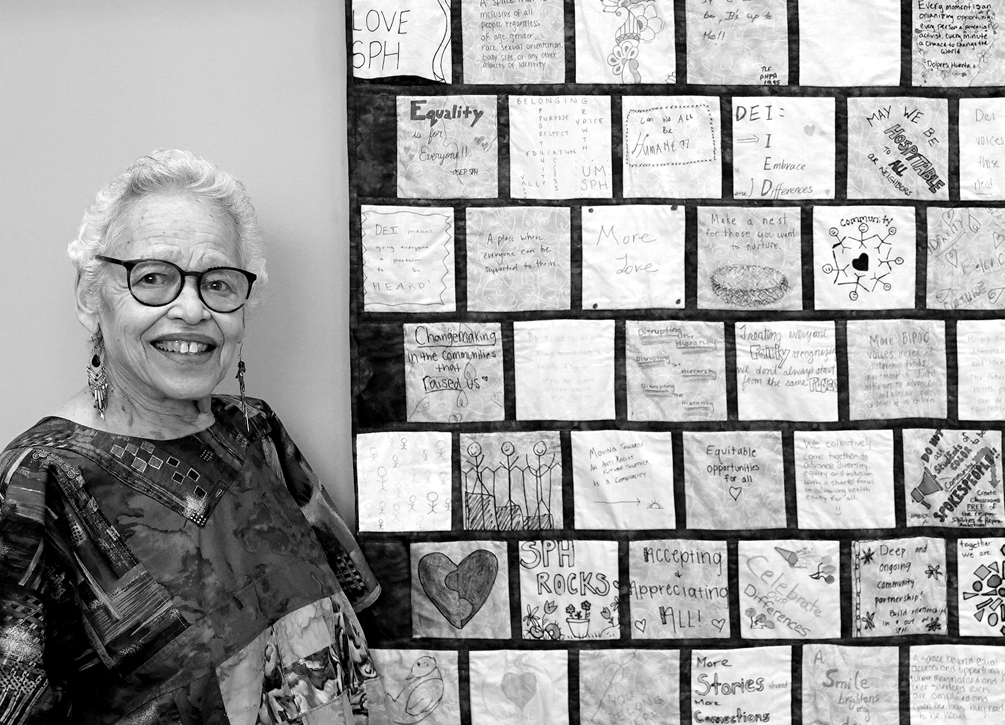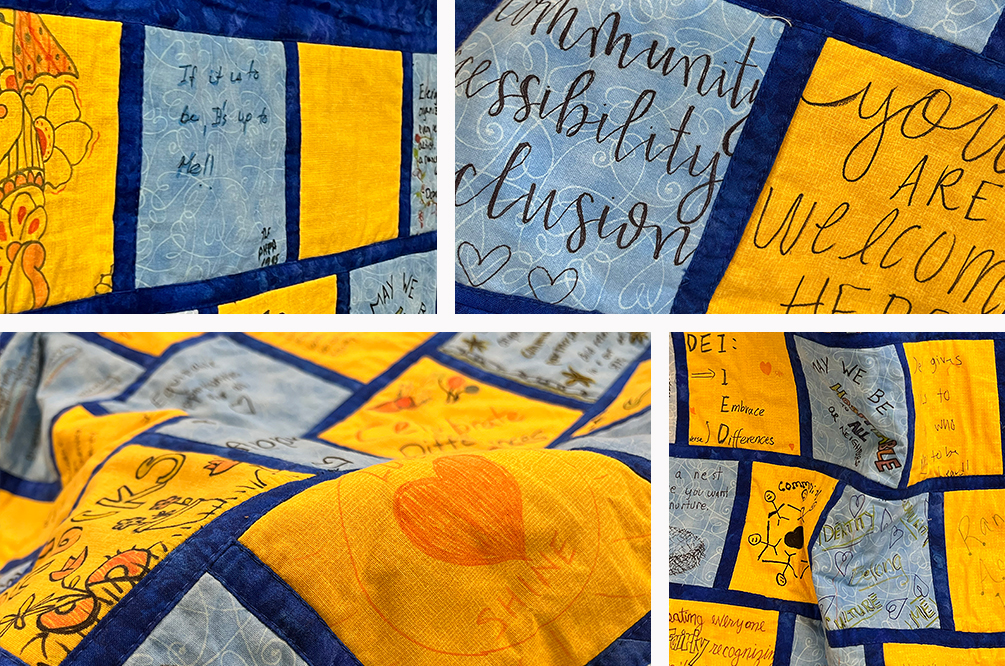Building inclusive DEI strategies, one block at a time

Theadra Fleming, MPH ’95
Public Health Policy
Shortly after this profile was published, Theadra Fleming passed away unexpectedly. The School of Public Health community is devastated by this loss. Theadra contributed so much to the field of public health and to our school, and we are honored to share her story.
•
By Amber Stark
Inspiration can come from anywhere—a song, a once-forgotten conversation, a scene playing out at the grocery store.
For Theadra Fleming, MPH ’95, inspiration for one of the most meaningful projects of her life came from the brick pattern on the outside of her house.
“I was sitting on the porch one day, trying to figure out how to design a quilt that represents diversity and inclusion, when I noticed the bricks on the wall next to me,” she said. “I saw how they were staggered and thought about how that construction created stability and unity. I thought about how each individual brick was important, just like each individual person is important.”
“Each individual person is important” is a fitting thought in relation to a quilt commissioned by the University of Michigan School of Public Health to represent a shared vision for a more inclusive, equitable and diverse school.
A strength of the Michigan Public Health community is its commitment to attracting, training and engaging students, faculty and staff from different backgrounds, cultures, values and perspectives.
As part of its commitment to diversity, equity, inclusion and anti-racism, the school’s Diversity, Equity and Inclusion team held an event focused on conversation, reflection and vision casting in the fall of 2022. The event included the sharing of results from an evaluation of the DEI 1.0 strategic plan, reflection on the school’s DEI work over the previous five years, and an imagining of what the school’s DEI work should look like in the coming year.

It also included an artistic activity led by Fleming, a Michigan Public Health alumna and expert quilter.
Event attendees, including students, faculty, staff and alumni, were led through an immersive experience in which they wrote their rich and diverse dreams for the School of Public Health on precut maize and blue fabric blocks.
“It was a humbling experience,” Fleming said. “Voices need to be heard, and it comes down to grassroots. Projects like this are designed to bring people together for the common goal of DEI. It’s time, in terms of the human race.”
I was sitting on the porch one day, trying to figure out how to design a quilt that represents diversity and inclusion, when I noticed the bricks on the wall next to me. I saw how they were staggered and thought about how that construction created stability and unity. I thought about how each individual brick was important, just like each individual person is important.”
Fleming designed the activity to center around people and their feelings and thoughts.
“I wanted to acknowledge the individual and their struggle for equity, diversity and inclusion throughout the history of this country,” she said. “By creating the quilt this way, we highlighted the essence of a human being’s soul—joy, fairness, hope.”
After people wrote and drew on the blocks, Fleming sewed them together mimicking the pattern on the outside of her house. To her, these 5-inch-by-5-inch blocks, which she intentionally cut all the same size to honor the theme of equality, represent the foundation of an effective DEI effort.
“From the ground up,” she said, “DEI efforts are both individual and collective. We all must be a part of this transition, and not just talk about it, but implement it. The guidance and intervention that’s being done by the University of Michigan, it’s like hot icing on a hot cake; it spreads all over.”
The quilt was unveiled at the DEI 2.0 Strategic Plan Rollout held in the fall of 2023. It will be permanently displayed near the lobby in SPH I.
Fleming, who shared her age as “70-something,” was born in Chicago and raised in Detroit. A nurse for most of her career, her position as school nurse at a Detroit school for pregnant teens ignited her interest in public health and subsequent master’s degree in Public Health Policy.
“The School of Public Health program was so in line with my vision about public health in terms of health education for moms and babies,” she said. “For the most part, teens are not taking it seriously. Access to care can be a challenge for them and their families if they don’t know how to navigate the healthcare industry. This job was the perfect opportunity to share resources with the girls, to instruct and guide them in their interactions with the healthcare industry, to enable them to become their own advocates, and to develop relationships with their doctors as opposed to the fragmented care they might have been used to.
“It was a dream job; I absolutely loved it. It gave me a sense that I was making an impact in a very small way.”
After retiring for health reasons, Fleming started making quilts.
“It became my therapeutic intervention, so to speak, and I fell in love with it,” she said. “One hundred quilts later, I’m still at it.”
Fleming enjoys talking about the history of quilt making, which dates back hundreds of years and has a unique place in African American history.
Many enslaved women came up with their own designs without formal education or training, and I was fascinated by that. I found it soothing in some ways that without these formal skills, they were still able to create these intricate designs for quilts. It’s extraordinary how they were able to think up these designs for their own use and share them with each other.”
She is a strong proponent of natural fibers, which she says pays homage to the thousands of people who worked in cotton fields, not just in the United States, but in other countries as well.
One of her favorite quilt blocks is the log cabin, which many historians believe was used in the time of the Underground Railroad to identify a safe house or safe place.
“Many enslaved women came up with their own designs without formal education or training, and I was fascinated by that,” she said. “I found it soothing in some ways that without these formal skills, they were still able to create these intricate designs for quilts. It’s extraordinary how they were able to think up these designs for their own use and share them with each other.”
Fleming is quick to say that she “just” put the fabric blocks together to form the Michigan Public Health quilt, although she did write on one of the blocks: “If it is to be, it is up to me.”
“What really makes the quilt special are the people who put their thoughts on the fabric,” she said. “These are human beings who have thoughts that are important to this initiative. It’s a reminder as we walk by it that we’re talking about and making decisions that affect individual people with feelings, thoughts and concerns.
“I hope it influences the classroom, staff meetings, board meetings and the way we implement policy.”

